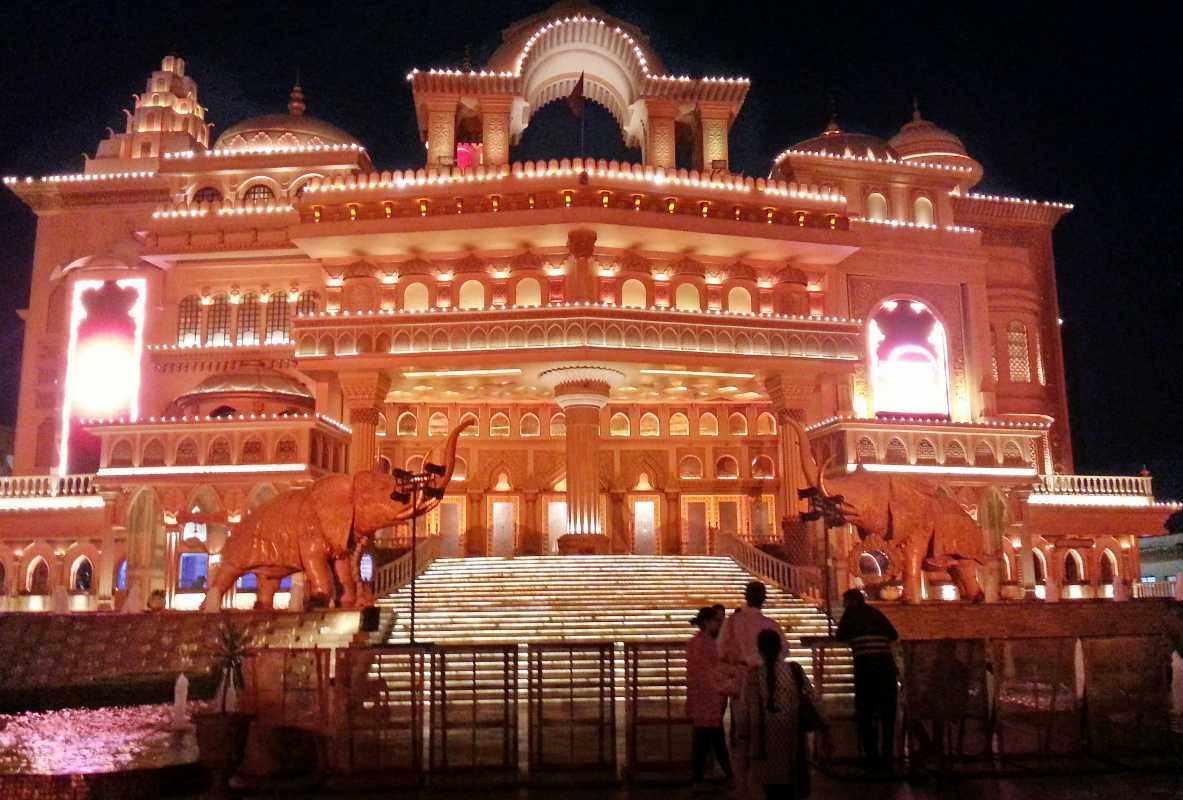Top 20 Best Amusement Parks & Arcades Company In India 2023
Top 20 Best Amusement Parks & Arcades Company In India 2023

Top 20 Best Amusement Parks & Arcades Company In India 2023
India is home to a vibrant and growing amusement park and arcade industry, offering a wide range of attractions and experiences for visitors of all ages and interests.
From water parks to indoor entertainment centres, these destinations provide thrilling rides, games, and activities that promise fun and excitement for everyone.
In this article, we will introduce the top 20 best amusement parks and arcades in India in 2023. These parks and arcades have been selected based on factors such as popularity, customer reviews, safety, and innovation, and are sure to provide visitors with unforgettable experiences.
Whether you’re a thrill-seeker, a water lover, or a gaming enthusiast, these destinations offer something for everyone and are must-visit destinations for anyone travelling to India.
Here are some of the top amusement parks and arcades companies in India, based on their popularity, visitor reviews, and overall reputation:
- Wonderla Holidays
- Adlabs Imagica
- EsselWorld
- Ramoji Film City
- Nicco Park
- MGM Dizzee World
- Worlds of Wonder
- Fun N Food Village
- Appu Ghar
- Snow World
- Fantasy World
- Black Thunder
- Funtasia Island
- Adventure Island
- Kingdom of Dreams
- Innovative Film City
- Funcity
- GRS Fantasy Park
- Ocean Park
- Smaaash
Wonderla Holidays

Wonderla Holidays is a leading amusement park and resort operator in India, with parks located in three cities – Bangalore, Hyderabad, and Kochi.
The company was founded in 2000 by Mr Kochouseph Chittilappilly and is headquartered in Bangalore.
Wonderla parks offer a wide range of attractions for visitors of all ages, including thrill rides, water rides, family rides, and kids’ rides. Some of the popular rides and attractions at Wonderla parks include roller coasters, water slides, wave pools, and lazy rivers.
Apart from the amusement parks, Wonderla also operates resorts near its parks in Bangalore and Kochi. The resorts offer comfortable accommodations, restaurants, and other facilities to guests.
Wonderla is known for its commitment to safety and has won several awards for safety and hygiene standards. The company also focuses on sustainability and has implemented several initiatives to reduce its environmental impact.
Overall, Wonderla Holidays has established itself as a trusted brand in the Indian amusement park industry, providing fun and exciting experiences for families, friends, and thrill-seekers.
Adlabs Imagica
_20181112222911_20181112223447.jpg)
Adlabs Imagica is a popular theme park located near Mumbai, India. The park was opened in 2013 and is owned by Adlabs Entertainment Limited, which is part of the Reliance Group.
The park is spread over 130 acres and features a variety of attractions, including roller coasters, water rides, and family-friendly rides.
Adlabs Imagica has six themed zones that are based on different concepts, such as Bollywood, mythology, and international destinations.
The park features several popular rides, including Nitro, which is one of the biggest roller coasters in India, and Rajasaurus River Adventure, which is a water ride with animatronic dinosaurs.
Apart from the rides, Adlabs Imagica also has several entertainment options, including live shows, street performances, and food and beverage options.
The park also has a snow park called Snow Park by Imagica, where visitors can experience snowfall and snow-related activities.
Adlabs Imagica is known for its high-quality facilities and customer service and has won several awards for its theme park experience.
The park attracts visitors from all over India and is considered one of the top amusement parks in the country.
EsselWorld

EsselWorld is a popular amusement park located in Mumbai, India. The park was opened in 1989 and is spread over an area of 64 acres.
It is owned by Essel Group, which is one of India’s largest conglomerates.
EsselWorld features a wide range of rides and attractions for visitors of all ages, including roller coasters, water rides, family rides, and kids’ rides.
Some of the popular rides at EsselWorld include Top Spin, Shot-N-Drop, and Thunder.
Apart from the rides, EsselWorld also has several entertainment options, including live shows, street performances, and food and beverage options.
The park also has a water park called Water Kingdom, which is located adjacent to EsselWorld.
EsselWorld is known for its high-quality facilities and customer service and has won several awards for its theme park experience.
The park attracts visitors from all over India and is considered one of the top amusement parks in the country.
EsselWorld has also implemented several sustainability initiatives to reduce its environmental impacts, such as rainwater harvesting, waste management, and solar energy usage.
Ramoji Film City

Ramoji Film City is a theme park and film studio located in Hyderabad, India. The park was opened in 1996 and is spread over an area of 2000 acres, making it one of the largest film studios in the world.
It is owned by the Ramoji Group, which is one of India’s largest conglomerates.
Ramoji Film City features several film sets, including replicas of famous international landmarks and famous Indian locations.
The park also has several rides and attractions, including a 4D theatre, a roller coaster, and a live stunt show.
Apart from the film sets and rides, Ramoji Film City also has several entertainment options, including live shows, dance performances, and food and beverage options.
The park also has several hotels and resorts that offer comfortable accommodations to visitors.
Ramoji Film City is known for its grandeur and attention to detail and has won several awards for its film studio experience.
The park attracts visitors from all over India and is considered one of the top tourist destinations in Hyderabad. It is also a popular location for film shoots and has been the filming location for several Indian and international movies.
Nicco Park

Nicco Park is an amusement park located in Kolkata, India. The park was opened in 1991 and is spread over an area of 40 acres. It is owned by the Nicco Group, which is a leading business conglomerate in eastern India.
Nicco Park features a wide range of rides and attractions for visitors of all ages, including roller coasters, water rides, family rides, and kids’ rides.
Some of the popular rides at Nicco Park include Cyclone, a wooden roller coaster, and Water Chute, a water ride.
Apart from the rides, Nicco Park also has several entertainment options, including a musical fountain show, a laser show, and food and beverage options.
The park also has several green spaces and gardens, making it a popular spot for picnics and family outings.
Nicco Park is known for its commitment to safety and has won several awards for its safety and hygiene standards. The park also focuses on sustainability and has implemented several initiatives to reduce its environmental impacts, such as rainwater harvesting and waste management.
Overall, Nicco Park has established itself as a popular amusement park in eastern India, providing fun and exciting experiences for families, friends, and thrill-seekers.
MGM Dizzee World

MGM Dizzee World is a popular amusement park located in Chennai, India. The park was opened in 1999 and is spread over an area of 27 acres.
It is owned by MGM Group, which is a leading business conglomerate in South India.
MGM Dizzee World features a wide range of rides and attractions for visitors of all ages, including roller coasters, water rides, family rides, and kids’ rides.
Some of the popular rides at MGM Dizzee World include the Dizzee Shake, a family-friendly ride, and the Big Wheel, a Ferris wheel with a height of 120 feet.
Apart from the rides, MGM Dizzee World also has several entertainment options, including a musical fountain show, a laser show, and food and beverage options.
The park also has several green spaces and gardens, making it a popular spot for picnics and family outings.
MGM Dizzee World is known for its customer service and has won several awards for its theme park experience. The park also focuses on sustainability and has implemented several initiatives to reduce its environmental impacts, such as rainwater harvesting and waste management.
Overall, MGM Dizzee World is a popular amusement park in South India, providing fun and exciting experiences for families, friends, and thrill-seekers.
Worlds of Wonder

Worlds of Wonder, also known as WOW, is a popular amusement and water park located in Noida, a city near New Delhi, India.
The park was opened in 2007 and is spread over an area of 10 acres. It is owned by Entertainment City Limited, which is a subsidiary of the Parsvnath Group, a leading real estate company in India.
Worlds of Wonder features a wide range of rides and attractions for visitors of all ages, including roller coasters, water rides, family rides, and kids’ rides.
Some of the popular rides at Worlds of Wonder include Rapid, a high-speed water slide, and the Mega Disco, a spinning disco-themed ride.
Apart from the rides, Worlds of Wonder also has several entertainment options, including a musical fountain show, a laser show, and food and beverage options.
The park also has several green spaces and gardens, making it a popular spot for picnics and family outings.
Worlds of Wonder is known for its safety standards and customer service and has won several awards for its theme park experience.
The park also focuses on sustainability and has implemented several initiatives to reduce its environmental impacts, such as rainwater harvesting and waste management.
Overall, Worlds of Wonder is a popular amusement and water park in the Delhi-NCR region, providing fun and exciting experiences for families, friends, and thrill-seekers.
Appu Ghar

Appu Ghar is a popular amusement park located in Gurugram, India. The park was opened in 1984 and was the first amusement park in India.
It is owned by International Amusement Limited, which is a subsidiary of the IAL Group, a leading business conglomerate in India.
Appu Ghar features a wide range of rides and attractions for visitors of all ages, including roller coasters, water rides, family rides, and kids’ rides.
Some of the popular rides at Appu Ghar include the Rapid Racer, a high-speed water slide, and the Wave Pool, a large pool with artificial waves.
Apart from the rides, Appu Ghar also has several entertainment options, including a musical fountain show, a laser show, and food and beverage options.
The park also has several green spaces and gardens, making it a popular spot for picnics and family outings.
Appu Ghar is known for its commitment to safety and has won several awards for its safety and hygiene standards. The park also focuses on sustainability and has implemented several initiatives to reduce its environmental impacts, such as rainwater harvesting and waste management.
Overall, Appu Ghar is a popular amusement park in the Delhi-NCR region, providing fun and exciting experiences for families, friends, and thrill-seekers.
The park has recently undergone a major renovation and reopened in 2021 with several new attractions and experiences.
Snow World

Snow World is a popular indoor snow park located in Hyderabad, India. The park was opened in 2004 and is spread over an area of 17,000 square feet.
It is owned by Ocean Park Multitech Limited, which is a leading leisure and entertainment company in India.
Snow World is known for its indoor snow experience, which is created by using artificial snow machines and maintaining a constant temperature of -5°C.
Visitors can enjoy a wide range of activities in the snow park, such as snow sledging, snowboarding, snow play, and snowball fights.
Apart from the snow experience, Snow World also has several entertainment options, such as a 5D theatre, a laser show, and food and beverage options.
The park also has several green spaces and gardens, making it a popular spot for picnics and family outings.
Snow World is known for its customer service and has won several awards for its unique snow experience. The park also focuses on sustainability and has implemented several initiatives to reduce its environmental impacts, such as energy-efficient lighting and waste management.
Overall, Snow World is a popular indoor snow park in Hyderabad, providing a unique and exciting experience for families, friends, and visitors of all ages.
Fantasy World

There are several amusement parks and attractions named Fantasy World in India, so it’s difficult to provide information on a specific park without more context.
However, here’s some general information about amusement parks and attractions called Fantasy World:
Fantasy World is a popular name for amusement parks and attractions that provide a variety of rides and experiences for visitors of all ages.
These parks often feature roller coasters, water rides, family rides, and kids’ rides, as well as entertainment options such as shows, musical performances, and food and beverage options.
Many Fantasy World parks also have themed areas that transport visitors to different worlds and eras, such as medieval castles, futuristic cities, and enchanted forests.
These themed areas often have unique rides and attractions that are designed to fit the theme.
Overall, Fantasy World parks provide fun and exciting experiences for families, friends, and thrill-seekers. They are known for their commitment to safety and customer service, and often have initiatives in place to reduce their environmental impact.
Black Thunder

Black Thunder is a popular water park and theme park located in Mettupalayam, near Coimbatore in Tamil Nadu, India. The park was opened in 1996 and is owned by the Lakshmi Mills group, a leading business conglomerate in India.
Black Thunder features a wide range of water rides and attractions, such as water slides, wave pools, and lazy rivers. The park also has several dry rides and attractions, including roller coasters, family rides, and kids’ rides.
Some of the popular rides at Black Thunder include the Wild River Ride, the Surf Hill, and the Dragon Coaster.
Apart from the rides, Black Thunder also has several entertainment options, including a musical fountain show, a laser show, and food and beverage options.
The park also has several green spaces and gardens, making it a popular spot for picnics and family outings.
Black Thunder is known for its commitment to safety and has won several awards for its safety and hygiene standards.
The park also focuses on sustainability and has implemented several initiatives to reduce its environmental impacts, such as rainwater harvesting and waste management.
Overall, Black Thunder is a popular water park and theme park in Tamil Nadu, providing fun and exciting experiences for families, friends, and thrill-seekers.
The park has recently undergone a major renovation and reopened in 2021 with several new attractions and experiences.
Funtasia Island

Funtasia Island is a popular amusement park and water park located in Patna, Bihar, India. The park was opened in 2015 and is owned by R.L. Steel and Energy Ltd, a leading business group in India.
Funtasia Island features a variety of water rides and attractions, including water slides, wave pools, and lazy rivers. The park also has several dry rides and attractions, such as roller coasters, family rides, and kids’ rides.
Some of the popular rides at Funtasia Island include the Aqua Snake, the Cyclone, and the Wave Pool.
Apart from the rides, Funtasia Island also has several entertainment options, including a 7D theatre, a mirror maze, and food and beverage options.
The park also has several green spaces and gardens, making it a popular spot for picnics and family outings.
Funtasia Island is known for its commitment to safety and has won several awards for its safety and hygiene standards.
The park also focuses on sustainability and has implemented several initiatives to reduce its environmental impacts, such as rainwater harvesting and waste management.
Overall, Funtasia Island is a popular amusement park and water park in Bihar, providing fun and exciting experiences for families, friends, and thrill-seekers.
The park is known for its affordable pricing and has become a popular destination for local visitors and tourists alike.
Adventure Island

Adventure Island is a popular amusement park located in Rohini, Delhi, India. The park was opened in 2006 and is owned by International Amusement Limited, a leading entertainment company in India.
Adventure Island features a variety of rides and attractions, including roller coasters, water rides, family rides, and kids’ rides.
Some of the popular rides at Adventure Island include the Twister, the Lightning Bolt, and the Flip Out. The park also has several entertainment options, such as shows, musical performances, and food and beverage options.
Apart from the rides and attractions, Adventure Island also has several green spaces and gardens, making it a popular spot for picnics and family outings.
The park is known for its commitment to safety and has won several awards for its safety and hygiene standards. The park also focuses on sustainability and has implemented several initiatives to reduce its environmental impacts, such as rainwater harvesting and waste management.
Adventure Island is one of the largest amusement parks in Delhi and is a popular destination for families, friends, and thrill-seekers.
The park has a wide range of rides and attractions that cater to visitors of all ages and interests. It is known for its affordable pricing and has become a popular spot for locals and tourists alike.
Overall, Adventure Island provides fun and exciting experiences for visitors and is a must-visit destination for those visiting Delhi.
Kingdom of Dreams
Kingdom of Dreams is a popular entertainment destination located in Gurgaon, Haryana, India. The park was opened in 2010 and is owned by the Great Indian Nautanki Company, a joint venture between Wizcraft International Entertainment and Apra Group.
Kingdom of Dreams is a unique destination that showcases the rich cultural heritage of India through its various shows, performances, and attractions.
The park features several venues, including the Nautanki Mahal, a state-of-the-art theatre that hosts Broadway-style musicals and plays; the Culture Gully, a cultural and culinary experience that features street performances, food stalls, and handicraft shops; and the Showshaa Theatre, which showcases traditional Indian dance and music performances.
Apart from the shows and performances, Kingdom of Dreams also has several other attractions, such as a virtual reality ride, a mirror maze, and a Bollywood-themed café.
The park also has several green spaces and gardens, making it a popular spot for picnics and family outings.
Kingdom of Dreams is known for its unique and immersive experiences that showcase the diversity and richness of Indian culture.
The park has won several awards for its innovative approach to entertainment and its commitment to excellence. It is a must-visit destination for those who want to experience the magic and grandeur of India’s cultural heritage.
Innovative Film City

Innovative Film City is a popular entertainment destination located in Bidadi, Karnataka, India. The park was opened in 2008 and is owned by Innovative Group, a leading business conglomerate in India.
Innovative Film City features a variety of attractions and experiences, including a theme park, a water park, a wax museum, a haunted house, and a dinosaur park.
The park also has several movie sets, sound stages, and post-production facilities, making it a popular destination for filmmakers and movie buffs.
Apart from the attractions, Innovative Film City also has several restaurants, cafes, and food stalls, offering a range of cuisines and dining options.
The park also has several green spaces and gardens, making it a popular spot for picnics and family outings.
Innovative Film City is known for its commitment to innovation and creativity and has won several awards for its innovative approach to entertainment.
The park offers a unique and immersive experience that combines entertainment, education, and culture, making it a must-visit destination for families, friends, and thrill-seekers.
Overall, Innovative Film City provides a wide range of attractions and experiences that cater to visitors of all ages and interests, making it a popular destination in Karnataka.
Funcity

Funcity is a popular amusement park located in Chandigarh, India. The park was opened in 1997 and is owned by the SRS Group, a leading business conglomerate in India.
Funcity features a variety of rides and attractions, including roller coasters, water rides, family rides, and kids’ rides.
Some of the popular rides at Funcity include the Cyclone, the Giant Drop, and the Wave Pool. The park also has several entertainment options, such as shows, musical performances, and food and beverage options.
Apart from the rides and attractions, Funcity also has several green spaces and gardens, making it a popular spot for picnics and family outings.
The park is known for its commitment to safety and has won several awards for its safety and hygiene standards.
Funcity is one of the largest amusement parks in Chandigarh and is a popular destination for families, friends, and thrill-seekers.
The park has a wide range of rides and attractions that cater to visitors of all ages and interests. It is known for its affordable pricing and has become a popular spot for locals and tourists alike.
Overall, Funcity provides fun and exciting experiences for visitors and is a must-visit destination for those visiting Chandigarh.
GRS Fantasy Park

GRS Fantasy Park is a popular water park located in Mysore, Karnataka, India. The park was opened in 2004 and is owned by GRS Group, a leading business conglomerate in India.
GRS Fantasy Park features a variety of water rides and attractions, including slides, pools, and wave pools. Some of the popular rides at the park include the Aqua Tornado, the Boomerang, and the Lazy River.
The park also has several dry rides and attractions, such as the Bull Ride and the 5D theatre.
Apart from the rides and attractions, GRS Fantasy Park also has several green spaces and gardens, making it a popular spot for picnics and family outings.
The park is known for its commitment to safety and has won several awards for its safety and hygiene standards.
GRS Fantasy Park is one of the largest water parks in Mysore and is a popular destination for families, friends, and thrill-seekers.
The park has a wide range of rides and attractions that cater to visitors of all ages and interests. It is known for its affordable pricing and has become a popular spot for locals and tourists alike.
Overall, GRS Fantasy Park provides fun and exciting experiences for visitors and is a must-visit destination for those visiting Mysore.
Ocean Park

Ocean Park is a popular amusement park and marine mammal park located in Gandipet, Hyderabad, India. The park was opened in 2003 and is owned by Ocean Park Multi Tech Ltd.
Ocean Park features a variety of rides and attractions, including roller coasters, water rides, family rides, and kids’ rides.
Some of the popular rides at Ocean Park include the Sky Ride, the Tornado, and the Octopus. The park also has several marine animal exhibits, including dolphin shows, sea lion shows, and penguin shows.
Apart from the rides and attractions, Ocean Park also has several green spaces and gardens, making it a popular spot for picnics and family outings.
The park is known for its commitment to safety and has won several awards for its safety and hygiene standards.
Ocean Park is one of the largest amusement parks in Hyderabad and is a popular destination for families, friends, and thrill-seekers.
The park has a wide range of rides and attractions that cater to visitors of all ages and interests. It is known for its affordable pricing and has become a popular spot for locals and tourists alike.
Overall, Ocean Park provides fun and exciting experiences for visitors and is a must-visit destination for those visiting Hyderabad.
Smaaash

Smaaash is a popular indoor entertainment and gaming centre located in Mumbai, India. The centre was opened in 2012 and is owned by Smaaash Entertainment Pvt. Ltd.
Smaaash features a variety of games and attractions, including virtual reality games, arcade games, cricket simulators, bowling alleys, and go-karting tracks.
Some of the popular attractions at Smaaash include the Vertigo, the Finger Coaster, and the Walk the Plank VR experience.
Apart from the games and attractions, Smaaash also has several food and beverage options, making it a popular spot for parties and corporate events.
The centre is known for its innovative and immersive gaming experiences and has won several awards for its unique offerings.
Smaaash is one of the largest indoor entertainment centres in Mumbai and is a popular destination for families, friends, and gamers.
The centre has a wide range of games and attractions that cater to visitors of all ages and interests. It is known for its affordable pricing and has become a popular spot for locals and tourists alike.
Overall, Smaaash provides a fun and exciting experience for visitors and is a must-visit destination for those visiting Mumbai.
In conclusion, India has a thriving amusement park and arcade industry with many world-class destinations for visitors to enjoy.
From water parks to indoor entertainment centres, India offers a wide range of attractions and experiences for visitors of all ages and interests.
The top 20 amusement parks and arcades in India in 2023 provide fun and exciting experiences for visitors and are must-visit destinations for those travelling to India.
They also contribute significantly to the country’s tourism industry, generating employment opportunities and boosting the local economy.




